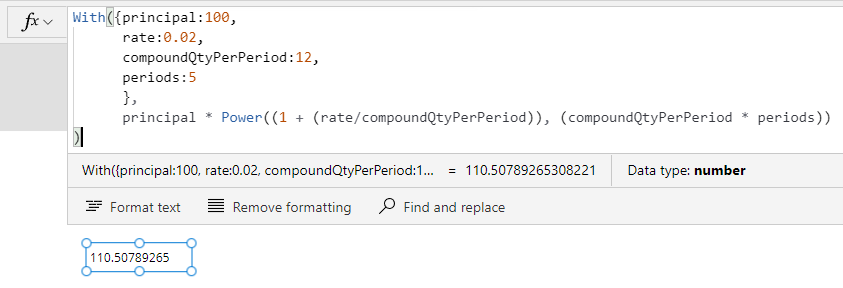Blog
Formula - How to calculate compound interest
November 24. 2022
When building financial applications, there can often be a requirement to calculate compound interest.
With Excel, the FV function can assist with this task. Unfortunately, there is no equivalent function in Power Apps or Power FX.
Therefore, the content of this post describes how to carry out this calculation from Power Apps.
Compound interest - an example calculation
For this post, let's take the following example question:
How much would $100 be worth when invested for 5 years at 2% (with interest paid monthly 12/year)?
To determine the answer, let's take one of the online calculators that we can find on the web. The screenshot below is taken from the following site:
https://www.thecalculatorsite.com/finance/calculators/compoundinterestcalculator.php
This shows that the result is $110.51 at the end of the 5-year period.

How to calculate compound interest in Power Apps
The generic formula to calculate compound interest (as described from the above site) looks like this:
A = P(1+r/n)^nt
A = the future value of the investment or loan
P = the principal investment or loan amount
r = the interest rate (decimal)
n = the number of times that interest is compounded per period
t = the number of periods the money is invested for
The equivalent formula in Power Apps would therefore look like this:
With({principal:100,
rate:0.02,
compoundQtyPerPeriod:12,
periods:5
},
principal *
Power((1 + (rate/compoundQtyPerPeriod)), (compoundQtyPerPeriod * periods))
)
With this formula, we would substitute the values inside the 'with' block like so:- principal - the principal investment/loan amount
- rate - the interest rate (eg - 2% would be expressed as 0.02)
- compoundQtyPerPeriod - number of times the interest is compounded per period. (in this example, 12 to express that the interest is compounded monthly)
- period - the number of periods the money is invested for (5 in this example)
If we test this expression from Power Apps, we see that it produces our expected result of 110.51 (rounded).
Conclusion
Where there is a need to calculate compound interest, we can use the formula in this post to carry out the calculation.
- Categories:
- formula
Related posts
- FormuIas - Is it possible to call a user-defined function recursively in Power Apps?
- Formulas - A beginners guide on how to create and call user-defined functions (UDFs)
- Formula - How to add a button that converts degrees Centigrade to Fahrenheit and vice versa
- Formula - How to convert a single delimited string to rows and columns
- Data - How to group data in a gallery and calculate sums
- Utilities - The best way to peform OCR on images of Power Apps Formulas
- Example - How to use a drop down control to convert currencies
- Formula - How to parse JSON in Power Apps- 4 examples
- Data - How to get a row by ordinal number
- Formula - What to do when the If statement doesn't work?
- Formula - Boolean And / Or operators - What is the order of precedence?
- Controls - How to set the data source of a Combo Box to a comma separated string
- Numbers - 10 examples of how to round numbers
- Formula - Difference between round, square, and curly brackets
- Top 3 highlights of upcoming enhancements to the Power Apps language (Power FX)
- Email - Sending email attachments with the Office 365 Outlook connector
- Formula - What to try when numbers don't format correctly
- Controls - How to convert HTML to Text
- Formulas - how to return all days between two dates
- Formula - How to create comma separated (CSV) list of items
- Formula - How to use the IF and Switch functions - 3 common examples
- Location - Finding the closest location and and sorting records by distance, based on the current location of the user
- Formulas - How to cope with weekends and public holidays in date calculations

